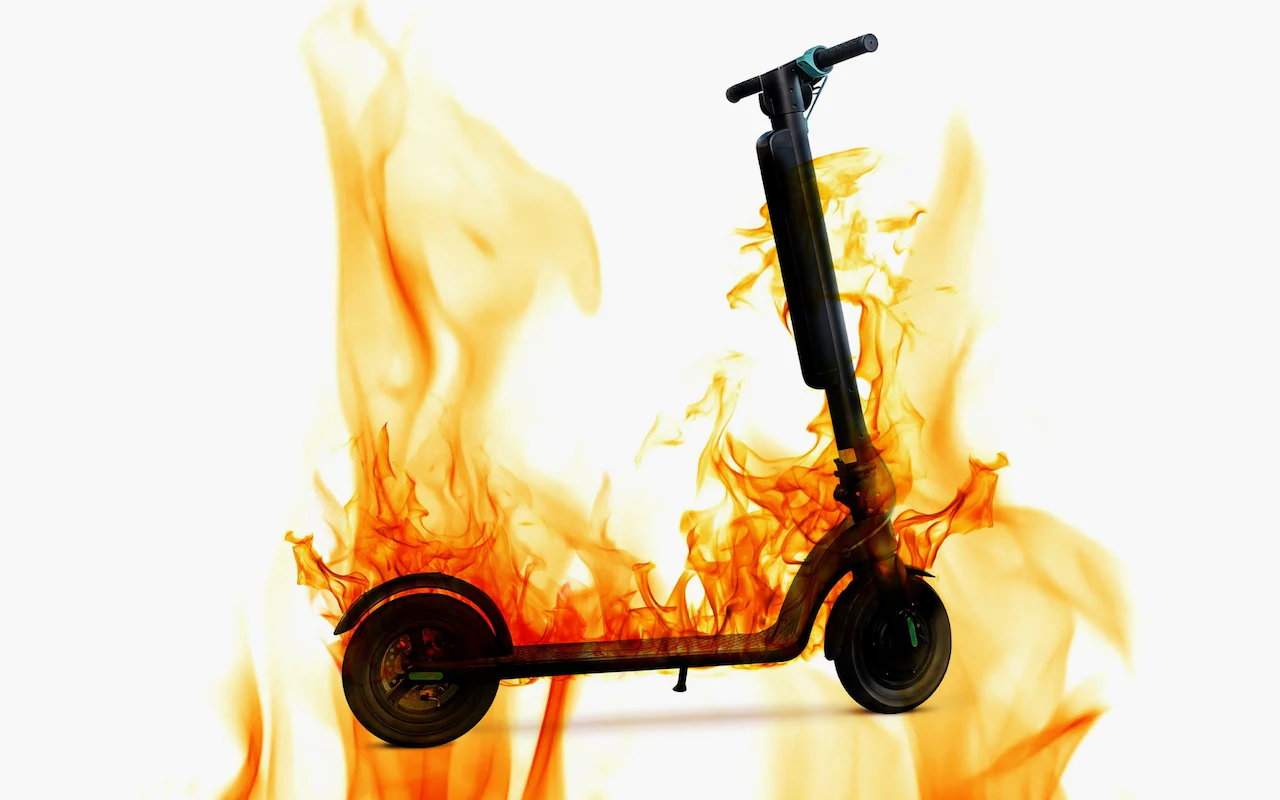Electric bicycles (e-bikes) and electric scooters (e-scooters) are becoming more and more popular in the workplace – both as a mode of transport for business purposes and a convenient way to commute.
These vehicles are normally powered by lithium-ion batteries, which obviously need charging regularly. But it’s now become clear that this brings some pretty serious safety risks.
In light of this, the government has just updated its guidance on how to manage the fire risk from e-bikes and e-scooters, so premises managers can act safely.
What’s the big deal?
E-bikes and e-scooters seem to be causing more and more fires in domestic and work premises. Government statistics report 159 incidents involving e-scooters and e-bikes in 2021, compared to 227 in 2022 and a forecasted 338 in 2023.
This is because the batteries in them can have catastrophic failures like explosions and rapid fires, which can potentially be caused by things like overcharging, overheating, damage or manufacturing defects.
Key workplace safety guidelines
The warning signs your e-bike or e-scooter battery is a fire hazard
A fire can develop quickly, within a few seconds, and often without warning. Smoke or a white vapour cloud can be the first start of battery failure and fire.
You must stop using or charging your battery immediately if you notice any of the following:
- Overheating: If your device’s battery feels extremely hot to the touch.
- Deformation: If your battery looks swollen. Similar signs include any type of lump or leak from the device.
- Noise: If your battery is making hissing or cracking sounds.
- Smell: If you notice a strong or unusual smell coming from the battery.
- Performance: If your battery does not fully charge or is taking longer to charge than normal.
- Smoke: If your battery or device is smoking.
If you spot any of these signs, then the batteries are likely to pose an extremely high fire risk and shouldn’t be permitted on premises or in vehicles.
Charging
- Strictly follow the manufacturer’s instructions during charging, and always unplug the charger once the charging cycle concludes. Never leave it charging unattended or charge it while you’re asleep.
- Make sure that you take into account the potential risks from charging e-bikes and scooters within your fire risk assessment and implement controls.
- Don’t allow e-bikes and scooters to be charged within fire or emergency escape routes.
- Only use chargers endorsed by the manufacturer for your specific product.
- Regularly check e-bikes and scooters for wear and tear, damage, or other issues, including any charging cables.
- To prevent overheating or fires, never cover chargers or battery packs during the charging process. Don’t charge or store batteries in direct sunlight or in hot locations (above 45⁰C).
- Don’t charge batteries or store e-bikes and e-scooters near materials which are flammable or likely to combust.
- Follow manufacturer’s guidance on battery charge durations to avoid overcharging.
- Exercise caution with socket outlets and extension leads, avoiding overloading and “daisy chaining”.
- In the event of an e-bike, e-scooter, or lithium-ion battery fire, don’t attempt to extinguish the flames unless you’ve got the right means to do so – like a specific lithium extinguisher and trained personnel.
- Charging should take place in a designated location where there’s automatic smoke detection present.
- If your battery can be removed from your e-bike or e-scooter and charged separately, it should be charged on a hard flat surface where heat can disperse and in an area with good ventilation.
Storage
- Avoid storing or charging e-bikes and e-scooters along evacuation routes or communal areas in multi-occupancy buildings, because this could cause problems with evacuating during a fire emergency.
- Responsible personnel should evaluate risks linked to e-bikes and e-scooters where they’re charged or left in common areas such as escape routes, bike storage, and mobility scooter charging zones.
- Offer guidance to colleagues on safe practices for usage, storage, and charging of e-scooters and bikes.
- Select storage locations for e-bikes, e-scooters, and their batteries that maintain moderate temperatures, avoiding extreme heat or cold.
- When lithium-ion batteries will be unused for extended periods, stick with the manufacturer’s instructions regarding storage and maintenance.
Considerations when buying these vehicles
- Source e-bikes, e-scooters, chargers, and batteries exclusively from reputable vendors.
- If they don’t meet British or European standards, they can pose significant fire hazards (search for UKCA and CE-marked e-bikes and scooters).
- Buy genuine chargers (or battery packs) because, though they’re sometimes more expensive, it’s a good idea to guarantee better quality and compatibility.
- Validate any provided warranties and register purchased products with the manufacturer to streamline communication for safety alerts or recalls.
- Make sure products are free from recalls by consulting resources like this Electrical Safety website or official government platforms.
E-bike conversion kits
- Pay special attention to bike conversion kits. Conversion kits change standard bicycles into e-bikes.
- It’s recommended that a professional carries out an e-bike conversion. They’ll be responsible for ensuring that the e-bike is safe and fitted with the correct motor, battery and charger.
- Don’t attempt to modify or tamper with the battery. Always follow the manufacturer’s instructions. Installing a conversion kit yourself could lead to safety issues with your e-bike and increase the risk of fire. It could also invalidate the manufacturer’s warranty and make you responsible for any consequent damage or accident.
Damage and proper disposal
Damaged batteries can unexpectedly overheat and catch fire, so it’s important to make sure that e-bikes and vehicles are disposed of properly and not mixed into your general waste.
Please refer to the manufacturer’s guidelines and your waste disposal company for further information of what to do in your local area.
What you must do if your lithium-ion battery is a fire risk
- If the device starts smoking or catches fire, raise the alarm, get out, and call 999 immediately.
- If your battery shows any signs of failure, turn off the device and unplug it from the power source immediately.





